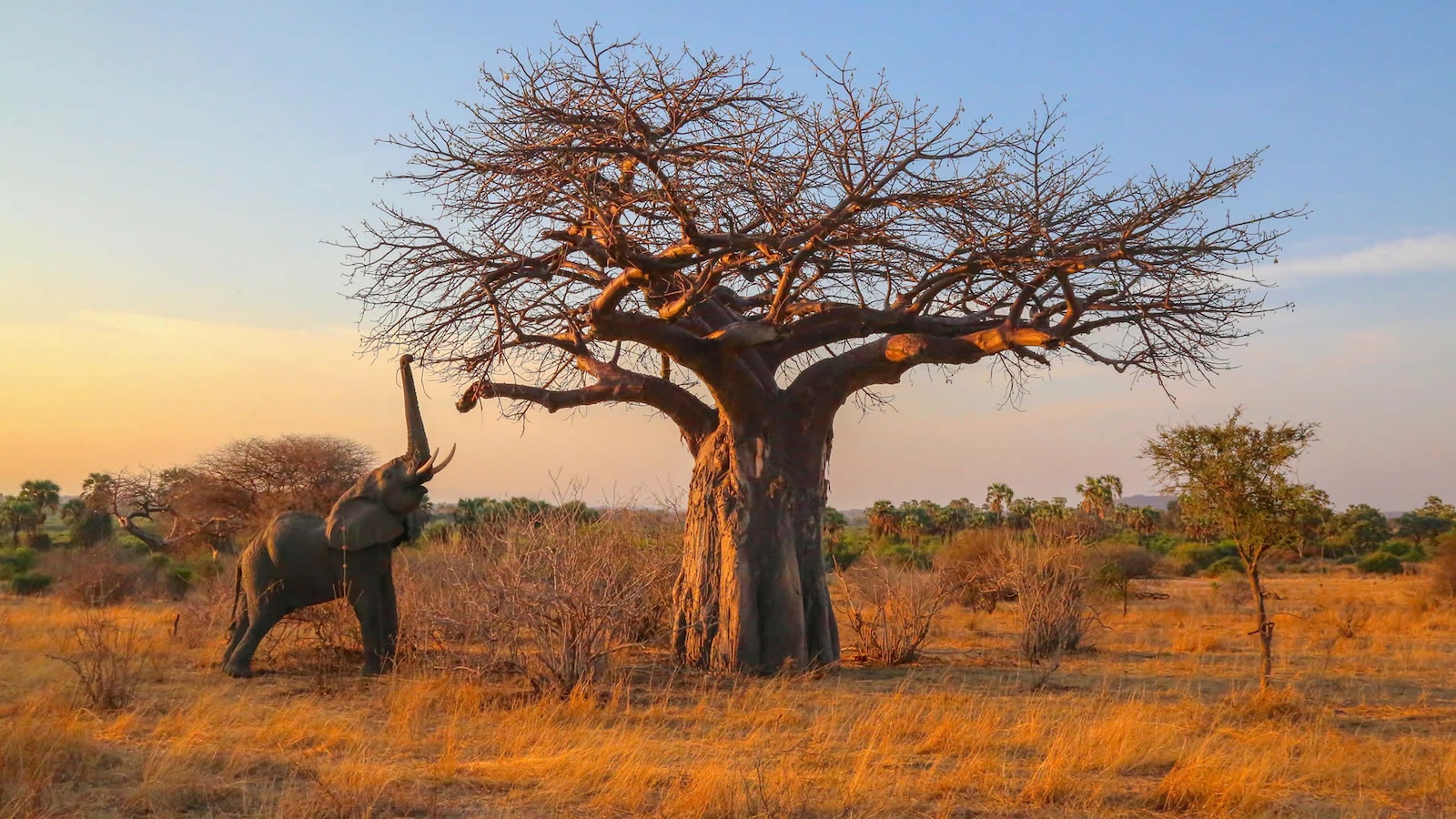Kenya and Tanzania stand as East Africa’s twin titans, weaving together a mesmerizing blend of untamed wilderness, towering peaks, sun-drenched coastlines, and cultures that pulse with history. Imagine tracking the Great Migration across the Serengeti, gazing at Mount Kilimanjaro’s snow-capped summit, or wandering the spice-laden alleys of Zanzibar.
These countries aren’t just destinations—they’re experiences that linger long after you’ve left. Whether you’re a wildlife enthusiast, an adventure seeker, or a beach lover, this comprehensive guide from safarikenyatanzania.com unveils the must-visit spots in Kenya and Tanzania, brimming with details to inspire your next trip.
Kenya’s Most Captivating Destinations
Kenya unfurls a kaleidoscope of landscapes, from the rolling savannahs of the Maasai Mara to the coral-fringed shores of Diani Beach. Each destination tells its own story, steeped in natural beauty and cultural richness. Below, we dive deep into the heart of Kenya’s most iconic places, offering you a front-row seat to their wonders.
Maasai Mara National Reserve
The Maasai Mara is Kenya’s beating heart of safari lore, a vast expanse where the earth trembles under the hooves of the Great Migration. Between July and October, over 1.5 million wildebeest, zebras, and antelopes surge across the Mara River, fleeing crocodiles and chasing greener pastures—a spectacle that’s as raw as nature gets. But the Mara’s magic isn’t seasonal.
Year-round, its golden grasslands teem with the Big Five—lions basking on kopjes, elephants lumbering through acacias, leopards draped in trees, rhinos grazing in secrecy, and buffalo glaring defiantly.
Cheetahs streak across the plains, their speed a blur, while hyenas cackle in the dusk. Beyond the wildlife, the Maasai people, adorned in crimson shukas, welcome visitors into their enkangs (villages), sharing songs, dances, and stories of a life intertwined with the land. Rise before dawn for a hot air balloon ride, drifting silently above the herds as the sun ignites the horizon, or embark on a night drive to catch nocturnal hunters in action.
The Maasai Mara isn’t just a destination—it’s a living, breathing epic, best experienced between July and October for the migration, though its allure never fades.
Amboseli National Park
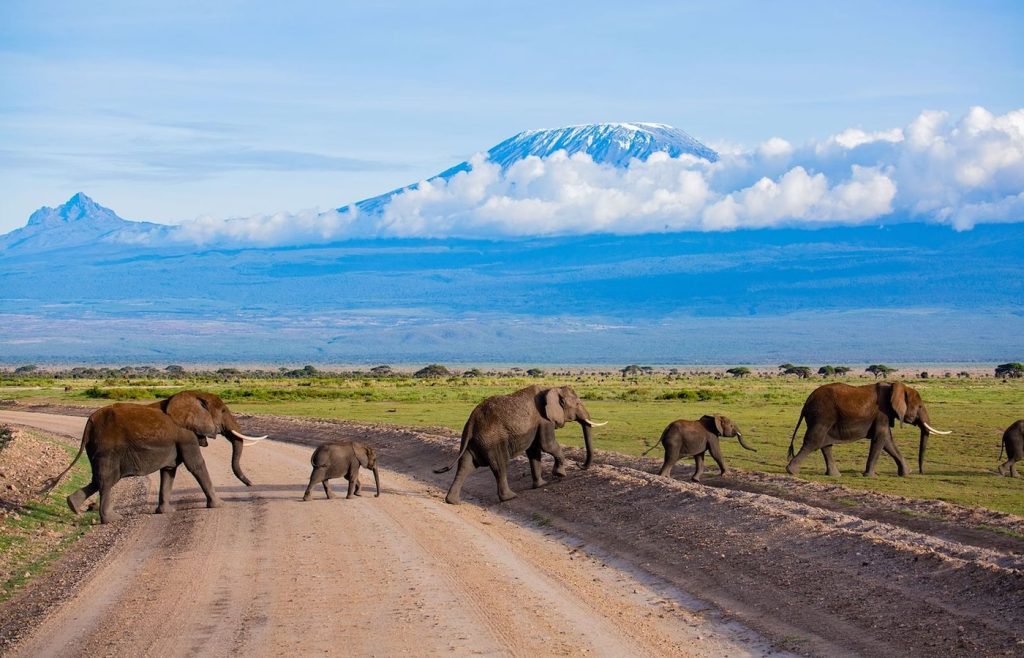 Amboseli National Park sits like a jewel at the base of Mount Kilimanjaro, its snow-dusted peak piercing the sky just across the Tanzanian border. This is elephant country—hundreds of these gentle giants roam the park’s swamps and plains, their trunks raised against a backdrop that’s postcard-perfect. The park’s compact 392 square kilometers pack a punch: lions prowl the grasslands, giraffes nibble acacia tops, and zebras stripe the horizon, all framed by Kilimanjaro’s majesty.
Amboseli National Park sits like a jewel at the base of Mount Kilimanjaro, its snow-dusted peak piercing the sky just across the Tanzanian border. This is elephant country—hundreds of these gentle giants roam the park’s swamps and plains, their trunks raised against a backdrop that’s postcard-perfect. The park’s compact 392 square kilometers pack a punch: lions prowl the grasslands, giraffes nibble acacia tops, and zebras stripe the horizon, all framed by Kilimanjaro’s majesty. During the dry season (June to October), the dust swirls, tinting the air amber, while the wet months (November to May) transform the swamps into a haven for flamingos and waterbirds. Climb Observation Hill for a 360-degree vista, or stake out the swamps at dawn when the light bathes the mountain in gold.
Amboseli’s accessibility from Nairobi—just a four-hour drive or a quick flight—makes it a favorite, but it’s the interplay of wildlife and scenery that keeps travelers returning. Visit in December to February for the clearest Kilimanjaro views, and bring a camera—few places rival this for photographic splendor.
Tsavo National Parks (East & West)
Spanning over 22,000 square kilometers, Tsavo East and Tsavo West form one of the planet’s largest protected areas, split by the Nairobi-Mombasa highway into two distinct realms. Tsavo West is a rugged wonderland of volcanic lava flows, rolling Chyulu Hills, and the Mzima Springs, where crystal-clear waters bubble up from underground, revealing fish, crocodiles, and hippos through an underwater viewing chamber.
The Ngulia Rhino Sanctuary here shelters the endangered black rhino, a testament to conservation efforts amid this wild terrain. Across the divide, Tsavo East stretches into vast, arid plains where “red elephants” roam—coated in the park’s iron-rich soil, they’re a surreal sight against the golden grass.
The Galana River carves through, drawing herds of buffalo and antelope, while lions and leopards stalk the shadows. Lugard Falls, a series of rapids, adds a dramatic flourish to Tsavo East’s raw beauty. Both parks offer game drives and hiking, with Tsavo West’s night safaris unveiling a nocturnal world of bushbabies and aardvarks. Visit from June to October for prime wildlife spotting, or February to March to dodge the crowds—Tsavo’s scale and solitude are unmatched.
Lake Nakuru National Park
Tucked into the Great Rift Valley, Lake Nakuru National Park is a compact 188-square-kilometer marvel that punches above its weight. The soda lake at its core once drew millions of flamingos, painting the shores pink, though their numbers ebb and flow with water levels—wet seasons (March to May) are your best bet to catch this avian spectacle.
Beyond the lake, acacia woodlands and rocky cliffs harbor white and black rhinos, their lumbering forms a stark contrast to the nimble Rothschild’s giraffes browsing nearby. Leopards slink through the undergrowth, while baboons chatter atop Baboon Cliff, a lookout offering sweeping views of the lake and its fringing forest.
The Makalia Falls, cascading at the park’s southern end, add a serene touch to this biodiversity hotspot, home to over 450 bird species, including pelicans and fish eagles. Game drives here are intimate, with wildlife often just meters away, and the park’s proximity to Nairobi (a three-hour drive) makes it a perfect day trip or overnight escape.
July to October brings dry weather and concentrated game, but the lush greenery of the rains has its own charm.
Ol Pejeta Conservancy
Nestled in the shadow of Mount Kenya, Ol Pejeta Conservancy sprawls across 360 square kilometers of Laikipia’s rolling plains, a sanctuary where conservation meets adventure. This is the last refuge of the world’s final two northern white rhinos, their gentle presence a poignant reminder of nature’s fragility—visitors can meet them up close, a rare privilege.
Beyond this headline act, Ol Pejeta teems with life: lions stalk the grasslands, elephants browse acacia thickets, and Grevy’s zebras, with their pinstripe coats, mingle with endangered black rhinos in one of East Africa’s largest populations. The Sweetwaters Chimpanzee Sanctuary adds a unique twist, housing rescued chimps in a riverside haven.
Game drives here feel personal—day or night, you’re immersed in a working ecosystem, with rangers sharing tales of anti-poaching victories. June to October’s dry season sharpens the wildlife focus, though March to May’s green flush draws birders with over 300 species. Just a four-hour drive from Nairobi, Ol Pejeta blends raw beauty with a mission—safari with a soul.
Samburu National Reserve
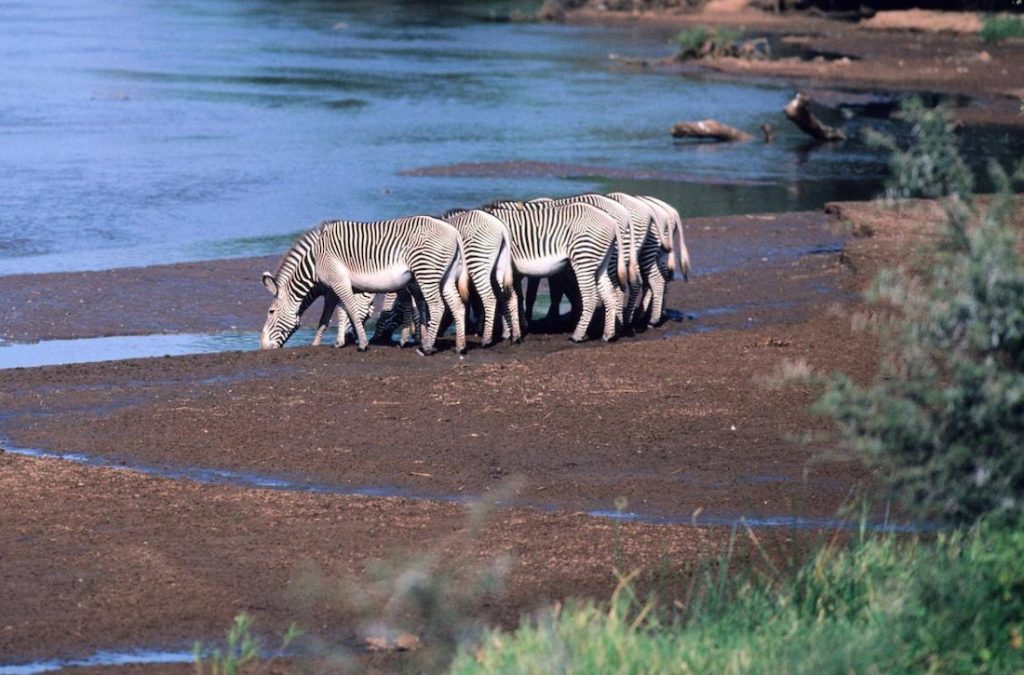 Samburu National Reserve unfurls along the Ewaso Ng’iro River in Kenya’s arid north, a 165-square-kilometer pocket of rugged beauty that feels worlds apart from the southern plains. The river is its lifeblood, fringed by doum palms and acacias that shelter rare species—the Grevy’s zebra, Somali ostrich, and gerenuk, an antelope that stands on hind legs to nibble high branches.
Samburu National Reserve unfurls along the Ewaso Ng’iro River in Kenya’s arid north, a 165-square-kilometer pocket of rugged beauty that feels worlds apart from the southern plains. The river is its lifeblood, fringed by doum palms and acacias that shelter rare species—the Grevy’s zebra, Somali ostrich, and gerenuk, an antelope that stands on hind legs to nibble high branches. Reticulated giraffes, their patchwork coats vivid against the red earth, roam alongside Beisa oryx and elephants, while lions, leopards, and cheetahs prowl the scrub. The Samburu people, cousins to the Maasai, add cultural depth—their manyattas (villages) dot the landscape, offering glimpses of pastoral life.
Buffalo Springs and Shaba reserves nearby expand the adventure, with springs and volcanic hills adding drama. July to October brings dry-season game concentrations, but the wet months (November to May) turn the riverbanks lush, luring birds like vulturine guineafowl. Samburu’s remote, untamed vibe—five hours from Nairobi or a short flight—makes it Kenya’s hidden gem.
Meru National Park
Meru National Park lies in Kenya’s eastern reaches, a 870-square-kilometer wilderness of rivers, swamps, and thornbush that feels like a secret waiting to be uncovered. Once home to Elsa, the lioness of Born Free fame, Meru’s legacy is steeped in wild romance. Thirteen rivers crisscross the park, feeding grassy plains where elephants, buffalo, and hippos thrive, while lions and leopards haunt the shadows.
The park’s isolation—six hours from Nairobi—keeps crowds thin, letting you savor its quiet magic: reticulated giraffes browsing, lesser kudus darting through thickets, and over 400 bird species, from kingfishers to martial eagles, filling the air.
The Rhino Sanctuary near the main gate protects both black and white rhinos, their grazing forms a testament to Meru’s revival after poaching scars. June to October’s dry season is prime for game drives, though the rains (March to May) paint the landscape green and swell the Tana River. Meru is Kenya’s wild heart—raw, serene, and timeless.
Lamu Archipelago
Far from the safari trails, the Lamu Archipelago floats off Kenya’s northern coast like a forgotten world. Lamu Island, the heart of this Swahili enclave, bans cars—donkeys clop through narrow stone streets, ferrying goods as they have for centuries. The Old Town, a UNESCO World Heritage Site, hums with history: intricately carved wooden doors, coral-stone houses, and mosques whisper of Arab, Indian, and African influences.
Beyond Lamu, Manda Island’s beaches stretch in quiet solitude, while Pate Island hides archaeological treasures like the ruins of Shanga. Dhow boats glide across turquoise waters, offering sunset sails or trips to snorkel among coral reefs teeming with parrotfish and rays.
The pace here is slow, the air thick with the scent of cloves and sea salt, and the annual Lamu Cultural Festival (November) brings music, dance, and donkey races to life. October to March offers dry, warm days ideal for exploring, though the short rains of November can add a misty charm. Lamu is Kenya’s coastal soul—perfect for unwinding after a safari.
Diani Beach
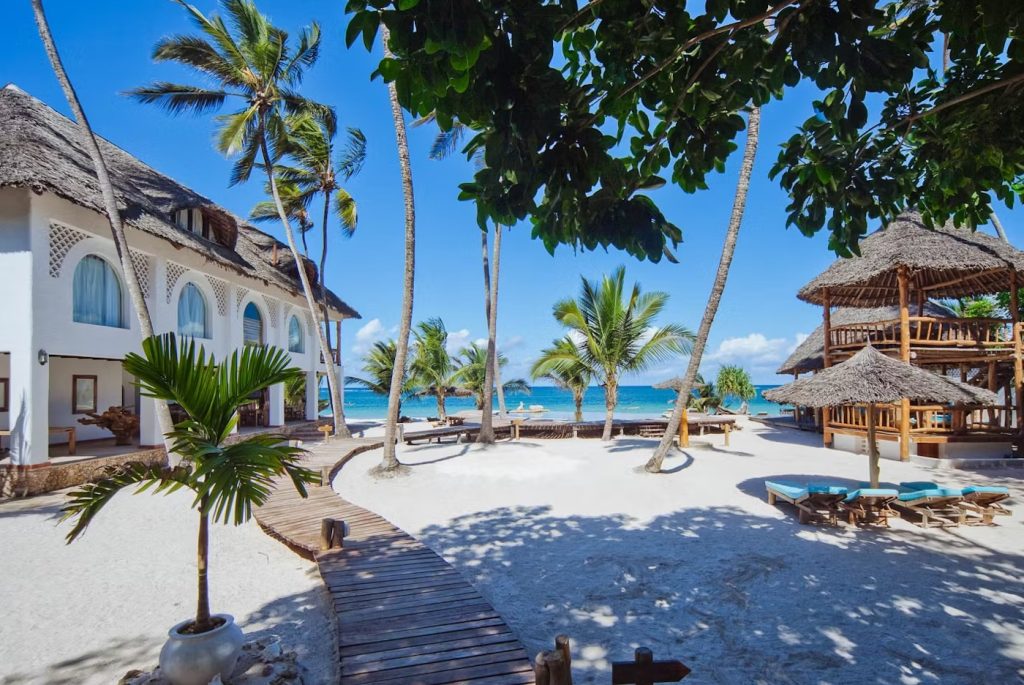 Diani Beach unfurls along Kenya’s southern coast like a ribbon of paradise, its powdery white sands kissed by the Indian Ocean’s turquoise waves. Palm trees sway above, framing a shoreline that’s equal parts relaxation and adventure.
Diani Beach unfurls along Kenya’s southern coast like a ribbon of paradise, its powdery white sands kissed by the Indian Ocean’s turquoise waves. Palm trees sway above, framing a shoreline that’s equal parts relaxation and adventure. Snorkel or dive in the Kisite-Mpunguti Marine Park, where coral gardens shelter dolphins, turtles, and schools of tropical fish, or ride the wind with a kite-surfing lesson. For a thrill, skydive over the coast, the aerial view revealing Diani’s full glory.
On land, the nearby Kaya Kinondo forest hides sacred groves and colobus monkeys, their black-and-white coats a flash among the trees. After a day of exploration, sip cocktails as the sun dips below the horizon, casting the beach in a fiery glow. October to March brings peak season warmth, though June to September’s cooler breezes appeal to those dodging crowds. Diani is the ultimate post-safari retreat, blending luxury with nature’s embrace.
Mount Kenya
Mount Kenya looms as Africa’s second-highest peak at 5,199 meters, a jagged crown of volcanic rock that dwarfs the surrounding plains. Less crowded than Kilimanjaro, it’s a trekker’s dream, with routes like Sirimon winding through bamboo jungles, Chogoria crossing moorlands dotted with giant lobelias, and Naro Moru tackling the steepest ascent to Point Lenana.
The mountain’s lower slopes teem with elephants, buffalo, and monkeys, while higher altitudes reveal an alien world of glaciers and tarns. Summiting takes five to seven days, rewarding climbers with vistas stretching to Kilimanjaro on clear mornings.
January to March and July to September offer the driest conditions, though snow dusts the peaks year-round.
For non-climbers, the foothills offer day hikes through forests alive with birdcalls. Mount Kenya is Kenya’s quiet giant—raw, challenging, and utterly captivating.
Tanzania’s Unforgettable Destinations
Tanzania sprawls across East Africa with a grandeur that’s hard to overstate—home to the Serengeti’s endless herds, Kilimanjaro’s towering presence, and Zanzibar’s spice-scented shores. These destinations weave a narrative of wild beauty and timeless allure, detailed below for your travel inspiration.
Serengeti National Park
The Serengeti National Park stretches across 14,750 square kilometers of Tanzania’s northern plains, a name synonymous with safari at its most epic. Here, the Great Migration unfolds—a relentless cycle where wildebeest, zebras, and gazelles chase the rains, peaking from December to July as they birth calves in the south and surge north toward Kenya.
Predators shadow their every move: lion prides guard kopjes, cheetahs sprint in deadly bursts, and crocodiles lurk in the Grumeti River’s muddy depths. The central Seronera region buzzes with year-round game, while the remote Lobo area in the north offers solitude amid acacia-dotted hills.
Hot air balloon rides lift you above this living theater, revealing the scale of the herds against a sunrise palette, while walking safaris (in select zones) bring you face-to-face with the bush’s smaller wonders—dung beetles, hornbills, termite mounds.
June to October’s dry season sharpens the wildlife focus, but the wet months’ emerald plains have their own magic. The Serengeti is Tanzania’s wild heartbeat, a must-see on any East African journey.
Ngorongoro Crater
 The Ngorongoro Crater is a geological marvel—a volcanic caldera 20 kilometers wide, its steep walls cradling a wildlife Eden unlike any other. Descend into this natural amphitheater, and you’re greeted by a density of life that’s staggering: black rhinos lumber through grasslands, flamingos fringe Lake Magadi, and lions doze beside hippo pools.
The Ngorongoro Crater is a geological marvel—a volcanic caldera 20 kilometers wide, its steep walls cradling a wildlife Eden unlike any other. Descend into this natural amphitheater, and you’re greeted by a density of life that’s staggering: black rhinos lumber through grasslands, flamingos fringe Lake Magadi, and lions doze beside hippo pools. Elephants browse the Lerai Forest’s yellow fever trees, while hyenas and jackals scavenge the leftovers of the crater’s 25,000 large animals. The rim, perched at 2,300 meters, offers jaw-dropping views, especially at dawn when mist swirls below. Maasai herders graze cattle along the crater’s edge, their red cloaks a vivid contrast to the green slopes.
Access is tightly managed—day trips from nearby lodges keep the experience pristine—and the dry season (June to September) ensures clear tracks and concentrated game. Year-round, though, the crater’s microcosm thrives, earning its nickname “Africa’s Garden of Eden.” It’s a safari distilled into one unforgettable day.
Mount Kilimanjaro
Mount Kilimanjaro rises 5,895 meters above Tanzania’s plains, a dormant volcano that’s Africa’s highest peak and a global trekking icon. Its ascent is a journey through ecosystems: coffee farms give way to dripping rainforests, then moorlands studded with giant groundsels, and finally the barren, icy summit of Uhuru Peak.
Routes vary in challenge and charm—Machame’s seven-day trek dazzles with scenery, Lemosho weaves through wildlife-rich forests, and Rongai offers a quieter northern approach. Climbers pass elephants and colobus monkeys at lower altitudes, while the summit’s glaciers glint under starlight.
January to March and June to October bring dry weather and clear skies, though altitude sickness is a real hurdle—acclimatization days and experienced guides (bookable via safarikenyatanzania.com) are key. Reaching the top, marked by a weathered sign, feels like touching the roof of Africa, with views stretching across the savannah. Kilimanjaro is Tanzania’s ultimate test of grit and wonder.
Zanzibar Archipelago
Zanzibar drifts off Tanzania’s coast, an archipelago where history and hedonism collide. Stone Town, the cultural hub, is a maze of coral-stone alleys where Arab traders, Swahili fishermen, and European explorers left their mark—visit the Sultan’s Palace or the Old Fort to feel the past pulse.
The air hums with clove and cinnamon, a legacy of the spice trade, and tours to plantations reveal their secrets. Beyond town, beaches like Nungwi and Kendwa dazzle with white sands and waters so clear you’ll spot fish from the shore. Dive Mnemba Atoll for coral reefs alive with moray eels and rays, or sail to Prison Island to meet giant Aldabra tortoises.
June to October’s dry season is peak time, though December to February’s warmth draws sun-seekers too. Ramadan shifts the vibe—quieter streets, richer traditions—so plan accordingly. Zanzibar is Tanzania’s soulful escape, a perfect cap to a safari.
Tarangire National Park
Tarangire National Park, south of Arusha, is Tanzania’s unsung hero, a 2,850-square-kilometer haven where ancient baobabs stand sentinel over rolling hills. The Tarangire River becomes a lifeline in the dry season (June to October), drawing elephant herds numbering in the hundreds—trunks raised, dusting themselves with red earth.
Giraffes bend gracefully to drink, zebras jostle at waterholes, and lions lurk in the shade, eyeing prey. Rare antelopes like gerenuks and fringe-eared oryx add intrigue, while 400-plus bird species—ostriches, hornbills, lovebirds—fill the air with color and sound. Night safaris reveal leopards and aardvarks, a thrill not found in busier parks.
The wet season (March to May) paints the landscape green, scattering the herds but luring birdwatchers with migrants. Tarangire’s quiet trails and towering trees offer a slower, deeper safari—ideal for those craving authenticity over crowds.
Selous Game Reserve (Nyerere National Park)
Once the Selous Game Reserve, now part of the sprawling Nyerere National Park, this 50,000-square-kilometer wilderness is Tanzania’s raw frontier. Far from the northern circuit’s bustle, it’s a place of untouched rivers and miombo woodlands, where the Rufiji River sets the rhythm. Boat safaris glide past hippos wallowing in muddy shallows, crocodiles basking on banks, and fish eagles swooping for prey—a waterborne adventure that swaps jeeps for oars.
On land, wild dogs—rare and elusive—roam alongside lions, elephants, and buffalo, while walking safaris let you feel the bush’s pulse up close: the crack of a twig, the scent of wild basil. July to October’s dry months concentrate game along the water, though the wet season’s inaccessibility (March to May) keeps it wild. Nyerere’s remoteness is its charm—a safari for purists seeking solitude and scale.
Lake Manyara National Park
Lake Manyara National Park squeezes big wonders into its 330 square kilometers, a narrow strip between the Rift Valley escarpment and a shimmering soda lake. The lake itself is a magnet for flamingos and pelicans, their pink and white hues vivid in the wet season (March to May), while hippos wallow in nearby pools.
The groundwater forest—a rarity in these parts—shelters tree-climbing lions, a quirky twist on savannah norms, lounging in acacias as baboons and blue monkeys swing overhead.
Elephants crash through the undergrowth, and the park’s 400 bird species, from silvery-cheeked hornbills to storks, make it a birder’s paradise. A canopy walkway lifts you into the treetops, while hot springs bubble at the lake’s edge, steaming with mineral warmth.
July to October’s dry season packs wildlife tight, but the rains bring lush beauty and fewer visitors. Lake Manyara is Tanzania’s intimate gem—small in size, vast in spirit.
Lake Eyasi
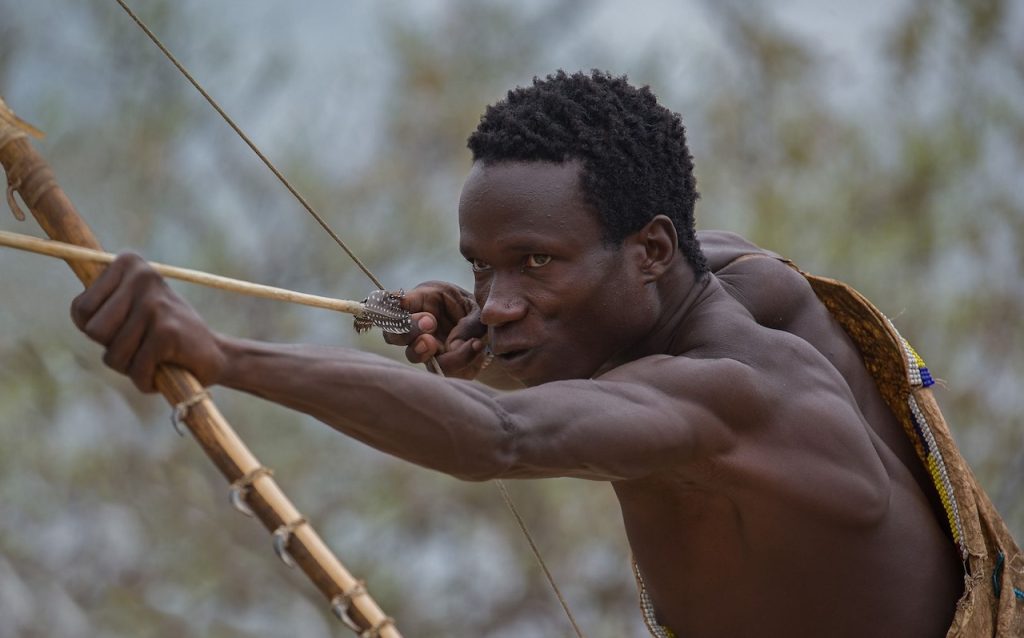 Lake Eyasi shimmers in Tanzania’s Rift Valley, a shallow soda lake southwest of the Ngorongoro Crater that’s less about scenery and more about soul. The Hadzabe bushmen, one of Africa’s last hunter-gatherer tribes, call this region home—join them at dawn to hunt with bows and arrows, tracking antelope or foraging for roots in a tradition unchanged for millennia.
Lake Eyasi shimmers in Tanzania’s Rift Valley, a shallow soda lake southwest of the Ngorongoro Crater that’s less about scenery and more about soul. The Hadzabe bushmen, one of Africa’s last hunter-gatherer tribes, call this region home—join them at dawn to hunt with bows and arrows, tracking antelope or foraging for roots in a tradition unchanged for millennia. The Datoga, skilled blacksmiths, live nearby, hammering iron into tools and jewelry you can watch take shape. The lake itself ebbs and flows with the seasons—dry months (June to October) shrink it to a salty crust, while rains (March to May) draw flamingos and pelicans to its shores. It’s a cultural immersion, not a wildlife spectacle, though baboons and small game roam the acacia scrub.
Accessible via Arusha (three-hour drive, with 1 hour on bumpy road), Lake Eyasi offers a raw, human connection to Tanzania’s past—best visited year-round, with dry seasons easing travel.
Lake Natron
Lake Natron broods in Tanzania’s far north, a caustic soda lake near the Kenyan border that’s as otherworldly as it gets. Its blood-red waters—stained by salt-loving bacteria—stretch beneath Ol Doinyo Lengai, an active volcano revered by the Maasai as “Mountain of God.” Flamingos breed here in the millions, their pink legions a surreal contrast to the stark, salty flats, especially during the wet season (March to May) when water levels rise.
The heat is relentless, often topping 40°C, and the lake’s alkalinity preserves fallen birds in eerie, statue-like forms. Hiking to the Engero Falls offers relief—a cool cascade amid the arid waste—while Maasai guides share tales of their sacred land.
June to October’s dry season makes access easier (a rough four-hour drive from Arusha), though the flamingo spectacle peaks earlier. Lake Natron is Tanzania’s alien frontier—harsh, haunting, and unforgettable.
Ruaha National Park
Ruaha National Park sprawls across 20,226 square kilometers in central Tanzania, a vast, untamed expanse where the Great Ruaha River carves through rocky hills and baobab-studded plains. It’s wilder and less trodden than the northern parks, with elephant herds numbering in the thousands—trunks raised against a rugged skyline. Lions rule here, their prides among Tanzania’s largest, while leopards, cheetahs, and rare wild dogs stalk the bush.
Sable and roan antelopes, elusive and elegant, graze alongside buffalo and giraffes, and over 570 bird species—carmine bee-eaters, Goliath herons—add splashes of color. Walking safaris and fly-camping plunge you into the wilderness, the river’s hippos and crocs a Ascend the kopjes at dusk for a glimpse of nocturnal life.
July to October’s dry season is peak time, though the wet months (March to May) turn the landscape lush. A six-hour drive from Iringa, Ruaha is Tanzania’s rugged soul—remote, raw, and richly rewarding.
Katavi National Park
Katavi National Park hides in western Tanzania, a 4,471-square-kilometer wilderness so remote it feels like the edge of the earth. The Katuma River and its floodplains—Lake Katavi and Lake Chada—draw massive hippo pods and crocodile lairs, their grunts and splashes echoing through the silence.
Elephants and buffalo roam in herds, lions and leopards shadow their trails, and sable antelopes gleam in the miombo woodlands. During the dry season (June to October), the shrinking waters concentrate game into a living spectacle—thousands of animals at a single mudhole, a scene of primal chaos.
The wet season (March to May) scatters the herds but paints the plains green, luring birds like storks and spoonbills. With fewer than 1,000 visitors a year, Katavi—reachable by charter flight from Dar es Salaam or a grueling drive—offers solitude and scale. It’s Tanzania’s wild west, untamed and unspoiled.
Mahale Mountains National Park
Mahale Mountains National Park clings to the shores of Lake Tanganyika in western Tanzania, a 1,613-square-kilometer paradise where mist-shrouded peaks plunge into turquoise waters. It’s chimpanzee country—over 1,000 wild chimps roam the dense forests, and trekking to find them is a heart-pounding thrill. You’ll hear their hoots before you see them—swinging through mahogany trees, grooming, or drumming on roots in a display of raw energy.
The park’s isolation—accessible only by boat from Kigoma (a five-hour ride)—keeps it pristine, with leopards, bushbucks, and 300 bird species adding to the chorus. June to October’s dry season is ideal for trekking, with clear trails and chimps lower in the canopy, though the wet months (March to May) bring lush beauty. After a hike, swim in the lake’s crystal depths, Africa’s deepest. Mahale is Tanzania’s wild Eden—remote, intimate, and alive.
Mikumi National Park
Mikumi National Park stretches across 3,230 square kilometers in southern Tanzania, a savannah gem sliced by the Dar es Salaam-Iringa highway. Its Mkata Floodplain mirrors the Serengeti in miniature—elephants trumpet through grasslands, giraffes tower over acacias, and lions sprawl on termite mounds, their manes catching the breeze.
Buffalo herds kick up dust, zebras stripe the horizon, and leopards slink through the bush, while over 400 bird species—lilac-breasted rollers, yellow-throated sandgrouse—flit above. The park’s accessibility—just four hours from Dar es Salaam—makes it a quick escape, yet it feels wild and free.
July to October’s dry season packs game along waterholes, though the rains (March to May) turn it verdant, drawing wading birds. Mikumi is Tanzania’s unsung star—compact, vibrant, and brimming with life.
Kenya vs. Tanzania: A Destination Duel
Kenya and Tanzania share a border and a safari legacy, but their destinations carve distinct paths. Kenya’s Maasai Mara and Tsavo dazzle with accessibility and variety—red elephants, flamingo lakes, and coastal escapes like Lamu and Diani weave a tapestry of contrasts.
Tanzania counters with scale: the Serengeti’s endless herds, Selous’s wild expanse, and Kilimanjaro’s lofty challenge dwarf their neighbors in sheer ambition. Kenya’s Mount Kenya offers a quieter climb, while Tanzania’s Zanzibar blends spice and sand with unmatched depth. Culturally, Kenya’s Maasai heritage shines bright; Tanzania’s Swahili coast hums with history.
Wildlife-wise, both boast the Big Five, but Tanzania’s crater and Tarangire add rare species like black rhinos and gerenuks. Can’t choose? A cross-border trip via safarikenyatanzania.com merges the best of both worlds—compact thrills and sprawling wonders in one epic itinerary.
Crafting Your Kenya & Tanzania Adventure
Planning a trip to these East African giants requires a bit of savvy. The dry seasons—June to October across both countries—promise prime wildlife viewing, with dust trails and waterholes drawing game in droves; January to March adds clear skies for climbing and coastal lounging.
Wet months (March to May) flood the plains with green, slashing crowds and prices, though roads can turn to muck—perfect for birders or budget travelers. Coastal hotspots like Zanzibar and Diani peak from December to February, their sands warm and inviting, while June to September’s cooler breezes suit the active set.
Fly into Nairobi for Kenya’s hubs—Maasai Mara, Amboseli, Lamu—or Dar es Salaam and Kilimanjaro International for Tanzania’s treasures, with regional flights or road transfers bridging the gaps. Pack light layers for chilly safari mornings, sturdy boots for treks, and swimwear for beach detours. Malaria precautions, sunscreen, and a zoom lens are non-negotiable.
Let SKT handle the details—custom tours, expert guides, and seamless logistics await.
Why Kenya & Tanzania Beckon
Kenya and Tanzania aren’t just places on a map—they’re gateways to Africa’s soul. From the Serengeti’s thundering herds to Lamu’s donkey-cloaked streets, these destinations blend raw nature with human stories.
Track lions in the Mara, summit Kilimanjaro, or sip spice tea in Zanzibar—every moment pulses with possibility. Safarikenyatanzania.com is your key to this East African odyssey, crafting journeys that linger in memory long after the dust settles. Dive in—your adventure begins now.
 Amboseli National Park sits like a jewel at the base of Mount Kilimanjaro, its snow-dusted peak piercing the sky just across the Tanzanian border. This is elephant country—hundreds of these gentle giants roam the park’s swamps and plains, their trunks raised against a backdrop that’s postcard-perfect. The park’s compact 392 square kilometers pack a punch: lions prowl the grasslands, giraffes nibble acacia tops, and zebras stripe the horizon, all framed by Kilimanjaro’s majesty.
Amboseli National Park sits like a jewel at the base of Mount Kilimanjaro, its snow-dusted peak piercing the sky just across the Tanzanian border. This is elephant country—hundreds of these gentle giants roam the park’s swamps and plains, their trunks raised against a backdrop that’s postcard-perfect. The park’s compact 392 square kilometers pack a punch: lions prowl the grasslands, giraffes nibble acacia tops, and zebras stripe the horizon, all framed by Kilimanjaro’s majesty.  Samburu National Reserve unfurls along the Ewaso Ng’iro River in Kenya’s arid north, a 165-square-kilometer pocket of rugged beauty that feels worlds apart from the southern plains. The river is its lifeblood, fringed by doum palms and acacias that shelter rare species—the Grevy’s zebra, Somali ostrich, and gerenuk, an antelope that stands on hind legs to nibble high branches.
Samburu National Reserve unfurls along the Ewaso Ng’iro River in Kenya’s arid north, a 165-square-kilometer pocket of rugged beauty that feels worlds apart from the southern plains. The river is its lifeblood, fringed by doum palms and acacias that shelter rare species—the Grevy’s zebra, Somali ostrich, and gerenuk, an antelope that stands on hind legs to nibble high branches.  Diani Beach unfurls along Kenya’s southern coast like a ribbon of paradise, its powdery white sands kissed by the Indian Ocean’s turquoise waves. Palm trees sway above, framing a shoreline that’s equal parts relaxation and adventure.
Diani Beach unfurls along Kenya’s southern coast like a ribbon of paradise, its powdery white sands kissed by the Indian Ocean’s turquoise waves. Palm trees sway above, framing a shoreline that’s equal parts relaxation and adventure.  The Ngorongoro Crater is a geological marvel—a volcanic caldera 20 kilometers wide, its steep walls cradling a wildlife Eden unlike any other. Descend into this natural amphitheater, and you’re greeted by a density of life that’s staggering: black rhinos lumber through grasslands, flamingos fringe Lake Magadi, and lions doze beside hippo pools.
The Ngorongoro Crater is a geological marvel—a volcanic caldera 20 kilometers wide, its steep walls cradling a wildlife Eden unlike any other. Descend into this natural amphitheater, and you’re greeted by a density of life that’s staggering: black rhinos lumber through grasslands, flamingos fringe Lake Magadi, and lions doze beside hippo pools.  Lake Eyasi shimmers in Tanzania’s Rift Valley, a shallow soda lake southwest of the Ngorongoro Crater that’s less about scenery and more about soul. The Hadzabe bushmen, one of Africa’s last hunter-gatherer tribes, call this region home—join them at dawn to hunt with bows and arrows, tracking antelope or foraging for roots in a tradition unchanged for millennia.
Lake Eyasi shimmers in Tanzania’s Rift Valley, a shallow soda lake southwest of the Ngorongoro Crater that’s less about scenery and more about soul. The Hadzabe bushmen, one of Africa’s last hunter-gatherer tribes, call this region home—join them at dawn to hunt with bows and arrows, tracking antelope or foraging for roots in a tradition unchanged for millennia. 
